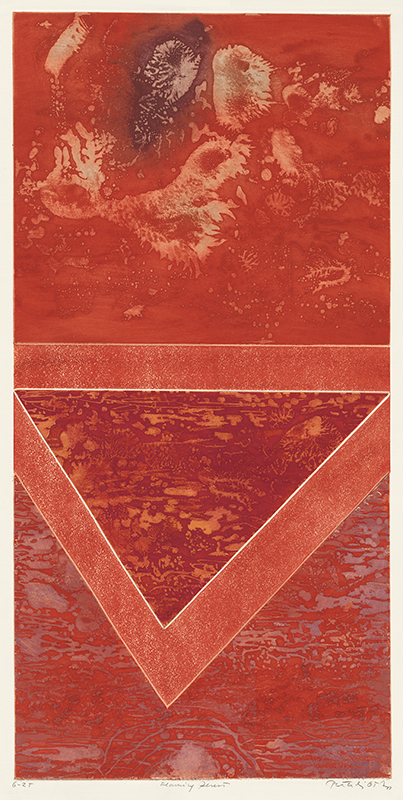Flaming Desert is a mixed technique color intaglio created in 1965 by Gabor Peterdi. It is pencil signed, titled, dated and editioned 6/25. The reference for Flaming Desert is number 227 in Gabor Peterdi: Graphics 1934-1969 where it is noted as a “combined technique in six colors.” This highly textural intaglio was printed by the artist on a sheet of coarse ivory wove paper. The platemark measures 36-3/4 x 17-7/8 inches. A variant color proof in the Syracuse Museum is listed as a “3 color etching embossing.”
One needs to view Flaming Desert in person to witness the brilliance of the color palette and the changing surface textures—the texture of the print suggests it was printed from a molten plate. It truly is a tour de force in printing.
In 1952 Peterdi wrote: The uncertainties of our century forced me to express them as they burst into futile and horrible action. But I believe in life, and it is this faith which now compels me to express the creative force of nature as a symbol of the triumph of life over destruction.
In her introduction to Gabor Peterdi Graphics 1934-1969, Una E. Johnson wrote: Landscape and the image of man are the two great themes that occupy the creative thought and energies of Gabor Peterdi. They are woven into his distinguished graphic oeuvre reflecting joyousness or introspection, exaltation or tragedy. Always they reveal an affirmation of life.
Louise S. Richards of the Cleveland Museum of Art wrote in her Peterdi exhibition catalogue of 1962: The one quality common to all of Peterdi’s prints is the fusion of his visual imagination with his mastery of print processes so that his prints develop through the natural interaction of the two—imagination demands appropriate technical invention and technical invention in turn stimulates a new vision.
Gabor Peterdi, painter, printmaker, author, and educator, was born on 17 September 1915 in Pestújhely, Hungary. He began his art studies at the Hungarian Academy in 1929 at the age of fourteen. His first solo exhibition was mounted at the Ernst Museum in 1930 and that same year Peterdi won a Prix de Rome scholarship for painting which allowed him to continue his studies at the Accademia di Belle Arti. The following year he went to Paris where he attended the Académie Julian and the Académie Scandinave. He joined Hayter’s Atelier 17 in Paris in 1933 where he explored the techniques of engraving.
Peterdi immigrated to the United States in 1939 and, later that year, his first American solo exhibition of paintings opened at the Julien Levy Gallery in New York. He soon became a United States citizen and joined the military serving in Germany. After his military service, Peterdi resumed his printmaking career at Atelier 17 in New York. He found working with the copperplate cathartic after his military experiences. His first prints reflected the horrors and destruction of war, but he soon began representing natural awakenings and biblical beginnings in such works as Adam and Eve.
He began teaching at the School of the Brooklyn Museum in 1948, organizing the graphic arts workshop there. Peterdi’s creative approach to intaglio continued to expand as he invented new techniques and printed from larger plates. In 1952, he became Associate Professor of Art at Hunter College, where he taught until 1959. In 1953, he began teaching at the Yale-Norfolk summer school, and he joined the art faculty of Yale University as a visiting professor, gaining a full-time appointment in 1960.
In 1959, Peterdi published his seminal book Printmaking Methods Old and New. It remains a standard technical reference for both printmaking students and professionals. Peterdi’s work garnered forty honors and is in the collections of the Museum of Fine Arts Boston, Massachusetts; the Brooklyn Museum, New York; the Art Institute of Chicago, Illinois; the Flint Institute of Art, Michigan; the Indianapolis Museum of Art, Indiana; the Hammer Museum, Los Angeles; the Memphis Brooks Museum of Art, Tennessee; the Yale University Art Gallery, New Haven, Connecticut; the Metropolitan Museum of Art, the Museum of Modern Art, the New York Public Library, and the Whitney Museum of American Art, New York; the Pennsylvania Academy of the Fine Art, Philadelphia; the Philadelphia Museum of Art, Pennsylvania; the National Gallery of Art and the Smithsonian American Art Museum, Washington, D.C.; and the Worcester Art Museum, Massachusetts.
Gabor Peterdi died in Stamford, Connecticut on August 13, 2001.



